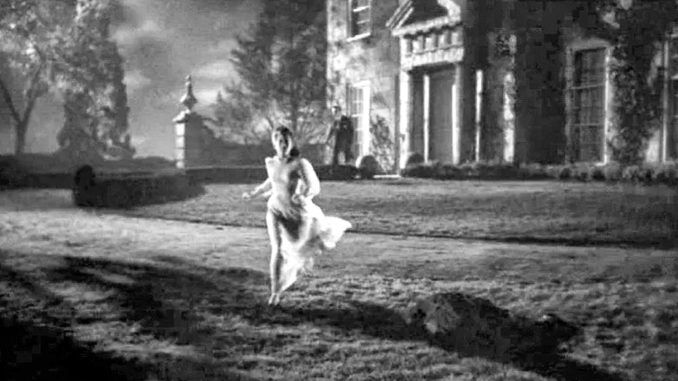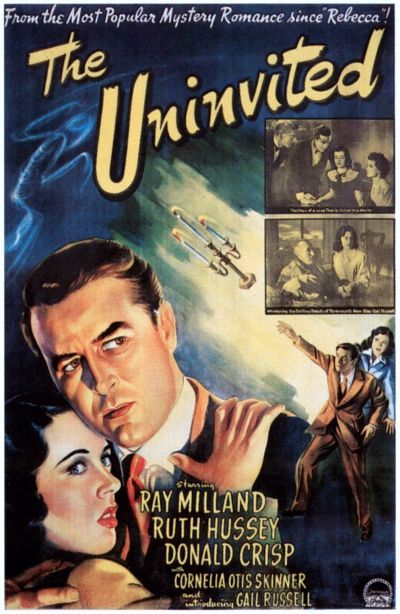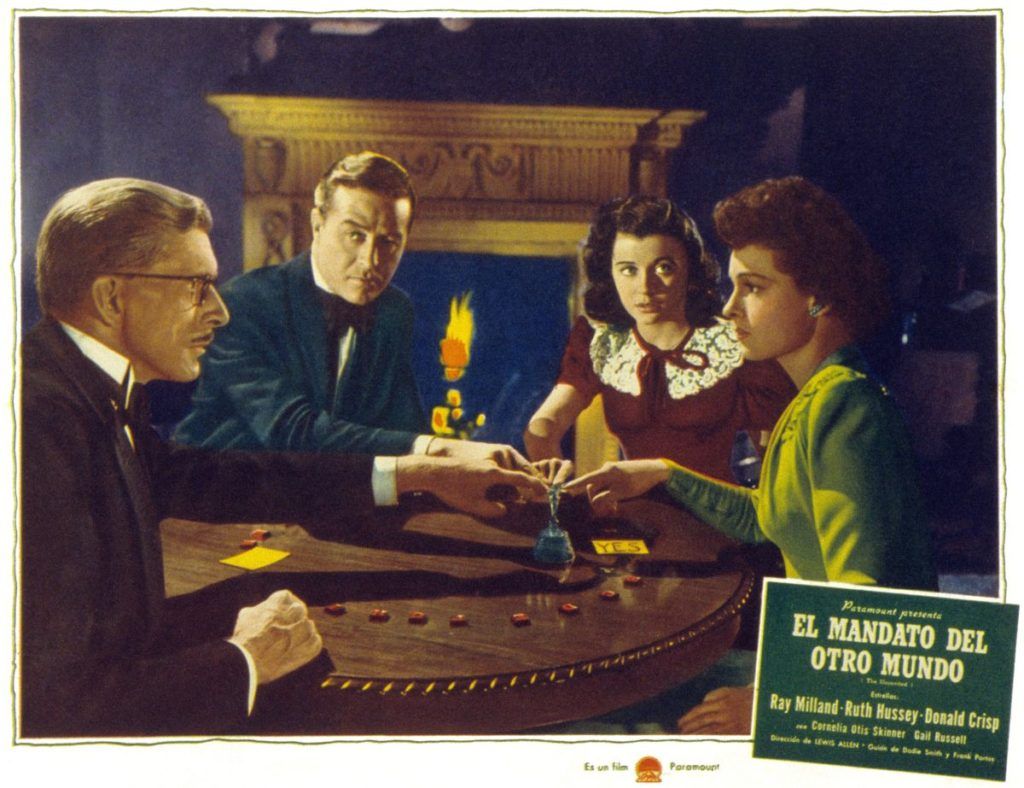
Rating: C
Dir: Lewis Allen
Star: Ray Milland, Gail Russell, Ruth Hussey, Donald Crisp
The menu continues to expand as we head back into the first half of the forties. No fewer than nineteen horror titles from this year qualified, with more than one thousand votes on the IMDb. This and The Scarlet Claw both received a 7.2, but the latter had fewer votes, and I’m also inclined not to pick a Sherlock Holmes film for the horror genre: The Pearl of Death also came out, and despite being well-rated (7.1), I feel similarly. Not everything with a murder in it is horror. I was interested in Curse of the Cat People, knowing its predecessor is coming in a bit. I recall actually preferring Curse, and was curious to see if that opinion had been sustained.
However, I hadn’t seen The Uninvited, and there’s no justifiable reason to replace it. It has a high rating, comfortably the most votes for any horror film of the year, while its tale of duelling ghosts and generally spooky atmosphere, are undeniably a genre fit. Particularly notable is a serious treatment of its spectral elements. Previously, things going bump in the night had mostly been seen as an opportunity for comedy: the same year as here saw The Canterville Ghost adopt the approach, and we’ll be getting to The Ghost Breakers in a few days. For occasional variety, spirits were sometimes used as a trigger for Scooby Doo-type antics, such as evil uncles faking them, to scare a niece out of an inheritance.
 No such frivolities are present here. The ghosts here are genuine, although by modern standards are largely ineffectual in the mundane world. Weeping and wailing? Sure, but beyond that, it’s mostly things like turning the pages of a book, and they peak with shattering a glass during a seance. Their physical form is fluttering pallidity, like drapes blowing gently in the wind. Though this is a restraint which is quite effective, and has probably stood the test of time better than any more ambitious use of the special effects technology available in the forties. It does make the understated reactions from most of the cast understandable. These are ghosts which will provoke mild to moderate concern, rather than screaming terror.
No such frivolities are present here. The ghosts here are genuine, although by modern standards are largely ineffectual in the mundane world. Weeping and wailing? Sure, but beyond that, it’s mostly things like turning the pages of a book, and they peak with shattering a glass during a seance. Their physical form is fluttering pallidity, like drapes blowing gently in the wind. Though this is a restraint which is quite effective, and has probably stood the test of time better than any more ambitious use of the special effects technology available in the forties. It does make the understated reactions from most of the cast understandable. These are ghosts which will provoke mild to moderate concern, rather than screaming terror.
The film takes place in “Cornwall” – quotes used, since it’s a intermittently convincing facsimile, filmed in Northern California and studio back-lots. While chasing after their dog, siblings Rick (Milland) and Pamela Fitzgerald (Russell) find an old, empty mansion, Windward House, with which they fall in love. They buy it from the owner, Commander Beech (Crisp), at the bargain price of £1,200, a sum so low it immediately had me scurrying for the inflation calculator, to figure out what this in modern money. The answer is, less than fifty thousand pounds. Wouldn’t get you a shack in the middle of a toxic waste dump these days. The Fitzgeralds choose to overlook this obvious red flag, along with the protestations of the Commander’s grand-daughter, Stella Meredith (Russell), that the house is not for sale.
It is not long before Rick and Pamela begin to have unusual experience. An artist’s studio is strangely cold; a woman is heard sobbing in the middle of the night; their animals won’t go upstairs, or run away entirely. The Commander has denied any supernatural cause. “No house is haunted,” he tells them, firmly, though goes on to admit, “But I had some tenants five years ago who complained of… disturbances.” No shit. Turns out Stella’s mother, Mary, fell to her death from a cliff near the house, when her daughter was aged three. The Fitzgeralds subsequently discover a murky family history, involving a Gypsy who modelled for Stella’s artist father, and subsequently had an affair with him. She was “a thorough bad lot”, according to village scuttlebutt.
These two women turn out to be the ghosts haunting Windward House, and are battling for control over Stella. Rick feels particularly responsible, since it seems he is developing feelings for her, despite Stella being virtually half his age: he, it was the forties. It was also, apparently, before “Don’t stick your dick in crazy,” was a well-known rule, because Stella is clearly quite troubled. What should they do to help this disturbed young woman? If your answered to the question is, “Let’s have a seance!” (below), give yourselves two points. The resulting ouija session is sanctioned by the local doctor, in what seems a fairly blatant threat to the bit of the Hippocratic Oath which says, “First, do no harm.” But by the time the credits roll, the truth is discovered, and all’s well that ends well.
 At one point, Alfred Hitchcock was connected to the project, albeit only for about a week. Might have had a darker tone if he had stuck around, though given his rep with actresses, it’s probably better for Russell this way. For by most accounts, she had a tough shoot as it was, and started drinking to calm her nerves. It started an issue with alcohol which plagued Gail for the rest of her life, until her untimely early death from liver damage at the age of 36. This is perhaps more affecting than the slight thrills provided here, although I can’t complain about the technical side, with Charles Lang Jr. rightfully being Oscar-nominated for his fine cinematography.
At one point, Alfred Hitchcock was connected to the project, albeit only for about a week. Might have had a darker tone if he had stuck around, though given his rep with actresses, it’s probably better for Russell this way. For by most accounts, she had a tough shoot as it was, and started drinking to calm her nerves. It started an issue with alcohol which plagued Gail for the rest of her life, until her untimely early death from liver damage at the age of 36. This is perhaps more affecting than the slight thrills provided here, although I can’t complain about the technical side, with Charles Lang Jr. rightfully being Oscar-nominated for his fine cinematography.
However, the script takes too damn long to meander to its point, instead preferring to give us… Stella and Rick going out for a sail. [Fun fact: co-author of the adaptation, from Dorothy Macardle’s novel Uneasy Freehold, was Dodie Smith. She’s best known for her novel, The Hundred and One Dalmatians, which would be turned into a Disney cash cow] And when it gets there, this is too genteel for its own good. This may be due to different audience expectations. Now, when we watch a ghost story, someone proclaiming that there’s a scent of mimosas is just not sufficient to strike fear into anyone’s heart, no matter how earnestly they say it.
This article is part of our October 2025 feature, 31 Days of Vintage Horror.
